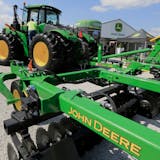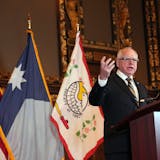Reading this story will not jinx anything.
So here it is: Despite Sunday's loss, the Minnesota Vikings are still contending for home-field advantage during the playoffs, and the better the 10-3 Vikings do, the more headaches they create for their NFL parent, which is hosting the Super Bowl at U.S. Bank Stadium on Feb. 4.
A Vikings home game in January would slash by more than half the five weeks the NFL has to reconfigure, remake and deck out the building for the Super Bowl. The league is scheduled to take over the building Jan. 2 and has big plans for it, from adding space for media to adding coat racks to some repainting.
"Everything is 'bigger and more' compared to a regular season or even a game in the playoffs," said Eric Finkelstein, senior director of event operations for the NFL. "Before the stadium was even built, we've been making trips out to Minnesota to see how everything would fit."
Should the Vikings get home-field advantage, they would be the first NFL team to do so the same year the Super Bowl was in their home stadium. Last year, the Houston Texans played — and lost — a wild card game, the first post-season game that occurs the weekend before the divisional and conference championships, so delays were minimal.
That's as close as the NFL has come to facing the conflicting needs of a home playoff team and Super Bowl preparations.
The $1.1 billion, 18-month-old U.S. Bank Stadium usually seats 66,200 for a Vikings game. The bowl can be expanded to accommodate 72,000. Instead, the NFL expects to drop the capacity for the Super Bowl to about 65,000 because they need space for the colossal media, security and entertainment at the event as well as additional luxury areas.
If the Vikings played the divisional game at home, scheduled for the Jan. 13-14 weekend, that would close the NFL's window for doing the build-out work to three weeks from five. If the Vikings advance to the conference game on Jan. 21, the NFL's build-out window would shrink to two weeks.



